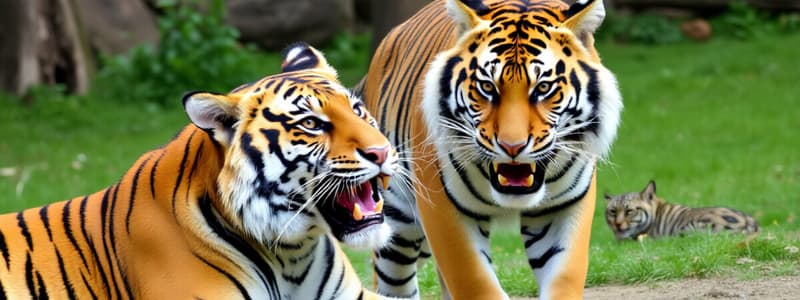Podcast
Questions and Answers
What distinguishes the conservation strategy employed with Boris and Svetlaya from previous approaches?
What distinguishes the conservation strategy employed with Boris and Svetlaya from previous approaches?
- Monitoring released tigers to ensure their well-being and reproductive success
- Using a combination of live prey and minimal human contact to stimulate natural behaviors
- Releasing orphaned tigers into the wild in separate, distant locations to promote population dispersal (correct)
- Releasing orphaned tigers into their natural habitat to reintegrate them with wild populations
Why were Boris and Svetlaya, despite being raised together, released into separate areas over 100 miles apart?
Why were Boris and Svetlaya, despite being raised together, released into separate areas over 100 miles apart?
- To observe their individual behaviors and survival rates in different geographic settings
- To test the effectiveness of releasing orphans in different environments
- To provide ample hunting grounds for each tiger without competition
- To prevent inbreeding and maintain genetic diversity within the wild population (correct)
What was the ultimate outcome of releasing Boris and Svetlaya in separate, distant locations?
What was the ultimate outcome of releasing Boris and Svetlaya in separate, distant locations?
- Both tigers struggled to adapt to life back in the wild and required further intervention from humans to survive
- They both thrived and formed successful breeding pairs within their allocated areas
- Boris wandered north in search of a suitable mate and ultimately found Svetlaya (correct)
- They both established their own territories and remained in their respective areas, creating a stable population in the Sikhote-Alin mountains
What does the phrase "to help spread the population of the endangered species over a wider area" imply?
What does the phrase "to help spread the population of the endangered species over a wider area" imply?
Based on the text, what is the significance of Boris and Svetlaya's successful reunion and subsequent breeding?
Based on the text, what is the significance of Boris and Svetlaya's successful reunion and subsequent breeding?
The text mentions that Zolushka, another released tiger, "produced a litter of healthy cubs". What does this tell us about Zolushka's success?
The text mentions that Zolushka, another released tiger, "produced a litter of healthy cubs". What does this tell us about Zolushka's success?
What is the most likely reason the researchers monitored Boris and Svetlaya after their release?
What is the most likely reason the researchers monitored Boris and Svetlaya after their release?
What does the phrase "to ensure their well-being" suggests about why Boris and Svetlaya were monitored?
What does the phrase "to ensure their well-being" suggests about why Boris and Svetlaya were monitored?
Flashcards
Boris
Boris
One of the rescued Amur tigers who reunited with Svetlaya.
Svetlaya
Svetlaya
The female Amur tiger who was rescued and later reunited with Boris.
Amur Tigers
Amur Tigers
A subspecies of tigers native to eastern Russia and parts of China.
Conservation Center
Conservation Center
Signup and view all the flashcards
Rehabilitation
Rehabilitation
Signup and view all the flashcards
Endangered Species
Endangered Species
Signup and view all the flashcards
Tiger Population Restoration
Tiger Population Restoration
Signup and view all the flashcards
Wildlife Conservation Society (WCS)
Wildlife Conservation Society (WCS)
Signup and view all the flashcards
Study Notes
Amur Tiger Reunion
- Boris and Svetlaya, rescued Amur tigers, reunited after a year apart, separated by over 100 miles.
- They were orphaned cubs, rescued at 3-5 months old and taken to a Siberian conservation center.
- Raised with minimal human interaction, given live prey (rabbits, pheasants) to develop hunting skills.
- Released into the Sikhote-Alin mountains at 18 months old, placed in separate regions.
- Researchers tracked the tigers, noticing Boris traveling towards Svetlaya's area.
- Their reunion led to Svetlaya giving birth to a litter of healthy cubs six months later.
- This reunion highlights the success of releasing rescued tigers back into the wild for population augmentation.
Conservation Efforts and Strategy
- The strategy of releasing rescued tigers into separate areas to broaden the population has not been studied before.
- Researchers published their findings about the reunited tigers in the Journal of Wildlife Management.
- The Wildlife Conservation Society (WCS) closely monitored Boris and Svetlaya's welfare.
- Another rescued tiger, Zolushka, was successfully released and later encountered a mate in the wild, leading to the birth of cubs.
- This suggests a potential strategy for increasing Amur tiger populations.
Amur Tiger Characteristics and Status
- Amur tigers (Siberian tigers) are the largest tiger subspecies, with thick pale orange coats and dark stripes.
- They are native to eastern Russia and parts of China, blending well in snowy landscapes and tolerating temperatures as low as -50°F (-46°C).
- They are solitary hunters and cover large areas, hunting deer and wild boar.
- Amur tigers were near extinction due to poaching and habitat loss.
- Current conservation efforts have increased their wild population to about 500.
- Despite remaining endangered, their population shows a renewed hope for preservation.
Studying That Suits You
Use AI to generate personalized quizzes and flashcards to suit your learning preferences.





